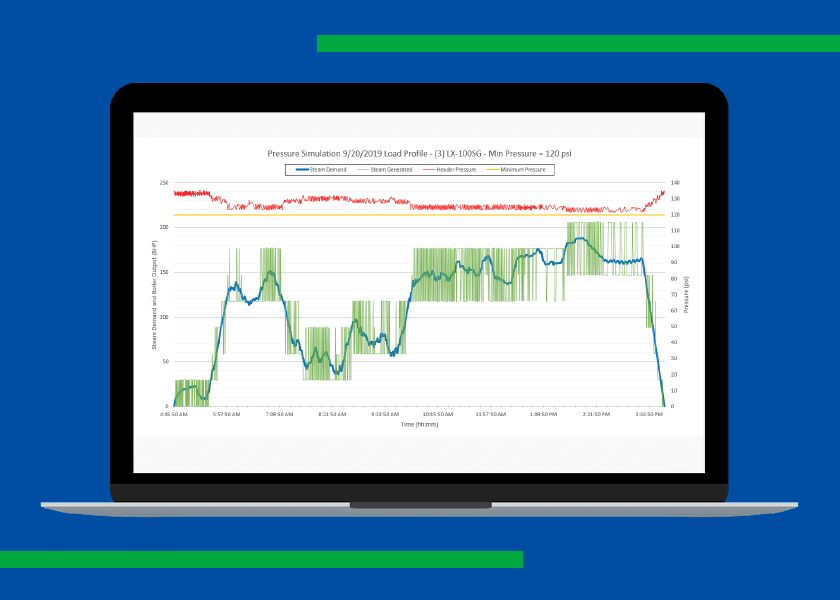How Pressure Simulations Benefit Steam Generation Efficiency
A variety of processes use steam, and each facility’s steam generation need is unique. A complete solution that’s custom-designed to fit boiler room size and output need but flexible to adapt to future changes is ideal. Modular water tube steam boilers are the best solution for maximum in-service efficiency and scalability.
To those unfamiliar with Miura’s modular, low water content design, there can be many questions and misunderstandings about the boiler function. A common misconception is that a low water content design boiler cannot handle sudden load swings. In reality, a Miura system can keep up with any steam demand profile with proper system design while providing higher efficiency than traditional systems.
Miura’s pressure simulation tool allows the engineering team to design the optimum system and test the system to see how individual boilers respond to the facility’s steam demand. System preferences such as how many stand-by boilers are kept hot and ready to come online rapidly are also analyzed to determine the proper control settings to balance reaction speed with efficiency. With many successful, large installations in America and across the world, our design is proven capable of matching all types of steam demand.
Part of the Miura advantage is a team of experts on your side to help fit a complete steam solution to match your exact needs – both before and after installation. Miura’s in-house boiler engineers assist customers by performing custom process simulations that reveal the best settings for maximizing demand efficiency. Here, we’ll discuss what this entails and the benefits it provides Miura boiler customers.
What is a Load Study vs. Pressure Simulation?
A pressure simulation is an automated steam demand pattern generated from customer data to predict the best steam boiler settings for maximum output efficiency. Typically, engineers begin with a load study to measure the steam demand for a facility’s current equipment output.
During a load study, engineers take initial measurements to determine the steam demand on the equipment currently installed as accurately as possible. A data logger records feedwater temperature, feedwater flow, steam pressure, and combustion analysis data in 30-second intervals. Engineers use this data to create a load study and guide new equipment selection if applicable.
To find the best settings to meet steam demand and maximize boiler performance, engineers perform a pressure simulation based on the load study data. The program simulates Miura boilers’ cycling through standby, low-fire and high-fire operating stages over a 10-48 hour interval. Engineers experiment with boiler arrangements and control settings to model the ideal boiler system. Experts calculate and analyze the simulation and present findings to the customer and representative branch with intuitive recommendations and an overview snapshot of the system’s ideal production cycle.
Pressure Simulation and Load Study Benefits
The main goal of a load study and pressure simulation is to discover and communicate the best settings to the customer and branch representative. The load study helps everyone understand the system and make appropriate recommendations that minimize efficiency loss.
A complete load study and pressure simulation package helps customers select the properly-sized steam boiler system to meet current demand. Having a system that exactly matches steam demand with the flexibility for future changes prevents overspending on a system that produces more steam than needed. Also, it saves valuable and costly resources used on a system that is too big for the current demand, all while minimizing emissions.
Understanding a Pressure Simulation Graph
In addition to a detailed report and recommendation explanation, engineers provide customers and branch representatives with load study and pressure simulation graphs. The example graph below shows the orange line as the boiler stack temperature in degrees Fahrenheit and the blue line as the boiler output measured in BHP.

The study measures boiler output and stack temperature against the average load, which includes a weekend shutdown in this example. Here, temperature and output spike during the daily startup and throughout the day. Using this load study information, engineers conducted a pressure simulation shown in the graph below.

Using three LX-100 boilers during the first day of the load study results in the above graph simulation. As the process demands steam, the system pressure drops, and the boilers increase steam output (measured in BHP) to maintain pressure. The pressure simulation models the behavior of each boiler to meet the exact steam demand of the existing system. Engineers complete a series of simulations like the one above to identify the most efficient and accurately sized system. Once engineers discover the best settings, these recommended settings are passed along for use and future reference.
In another recent customer study, the traditional firetube boiler was rated at 400 HP and shut down every day. The boiler held over 1,000 gallons of water and weighed over 25,000 pounds. The combined energy loss due to the boiler cooling down after every shift accounted for about 1.4% wasted energy. Switching to a Miura system reduced wasted energy to 0.2%. While 1.2% savings might seem small, a medium-sized boiler room could likely spend $1 million a year on fuel, and saving $12,000 a year over the next 20 years adds up to huge potential savings.
If you are a current Miura customer, reach out to us.info@miuraz.com if you’re interested in a pressure simulation study to help maximize your steam generation process potential.
Or, find a local Miura representative to find the right steam solution for your facility.

